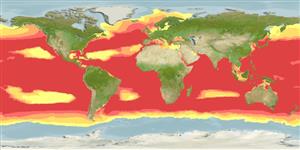Common names from other countries
Environment: milieu / climate zone / depth range / distribution range
экология
батипелагический; пределы глубины 0 - 1000 m (Ref. 96968). Subtropical
Worldwide except polar waters.
Length at first maturity / Size / Вес / Возраст
Maturity: Lm ? range ? - ? cm Max length : 45.0 cm TL самец/пол неопределен; (Ref. 96968)
Found in mesobathypelagic waters of tropical and subtropical regions (Ref. 115077). Depth range from near the surface to at least 1,000 m, typically over deep water (beyond the continental shelf) (Ref. 96968). Thought to be found mostly near islands and sea mounts (Ref. 115077). Video sequences from submersibles suggest that the male envelops the female within his webs during mating. Females are thought to brood their eggs within their arm crown (Ref. 96968). Faint and less developed beak could be a sign of soft-bodied prey diet of early stages (Ref. 115077).
Life cycle and mating behavior
половая зрелость | размножение | нерест | икра | Fecundity | личинки
Members of the class Cephalopoda are gonochoric. Male and female adults usually die shortly after spawning and brooding, respectively. Mating behavior: Males perform various displays to attract potential females for copulation. During copulation, male grasp the female and inserts the hectocotylus into the female's mantle cavity where fertilization usually occurs. Life cycle: Embryos hatch into planktonic stage and live for some time before they grow larger and take up a benthic existence as adults.
Основная ссылка
ссылки | координатор | соавторы
Turgeon, D.D., J.F. Quinn Jr., A.E. Bogan, E.V. Coan, F.G. Hochberg, W.G. Lyons, P.M. Mikkelsen, R.J. Neves, C.F.E. Roper, G. Rosenberg, B. Roth, A. Scheltema, F.G. Thompson, M. Vecchione and J.D. Willams. 1998. (Ref. 1667)
Статус Красного Списка МСОП (Ref. 130435)
Статус СИТЕС (Ref. 108899)
Not Evaluated
Not Evaluated
Использование человеком
| FishSource |
инструменты
дополнительная информация
Возраст/РазмерыростЗависимость между длиной и массой телаЗависимость между длинамиморфологияличинкичисленность
ресурсы в Интернет
Estimates based on models
Preferred temperature
(Ref.
115969): 6.1 - 20.4, mean 12.2 (based on 1932 cells).
Категория цены
Unknown.
